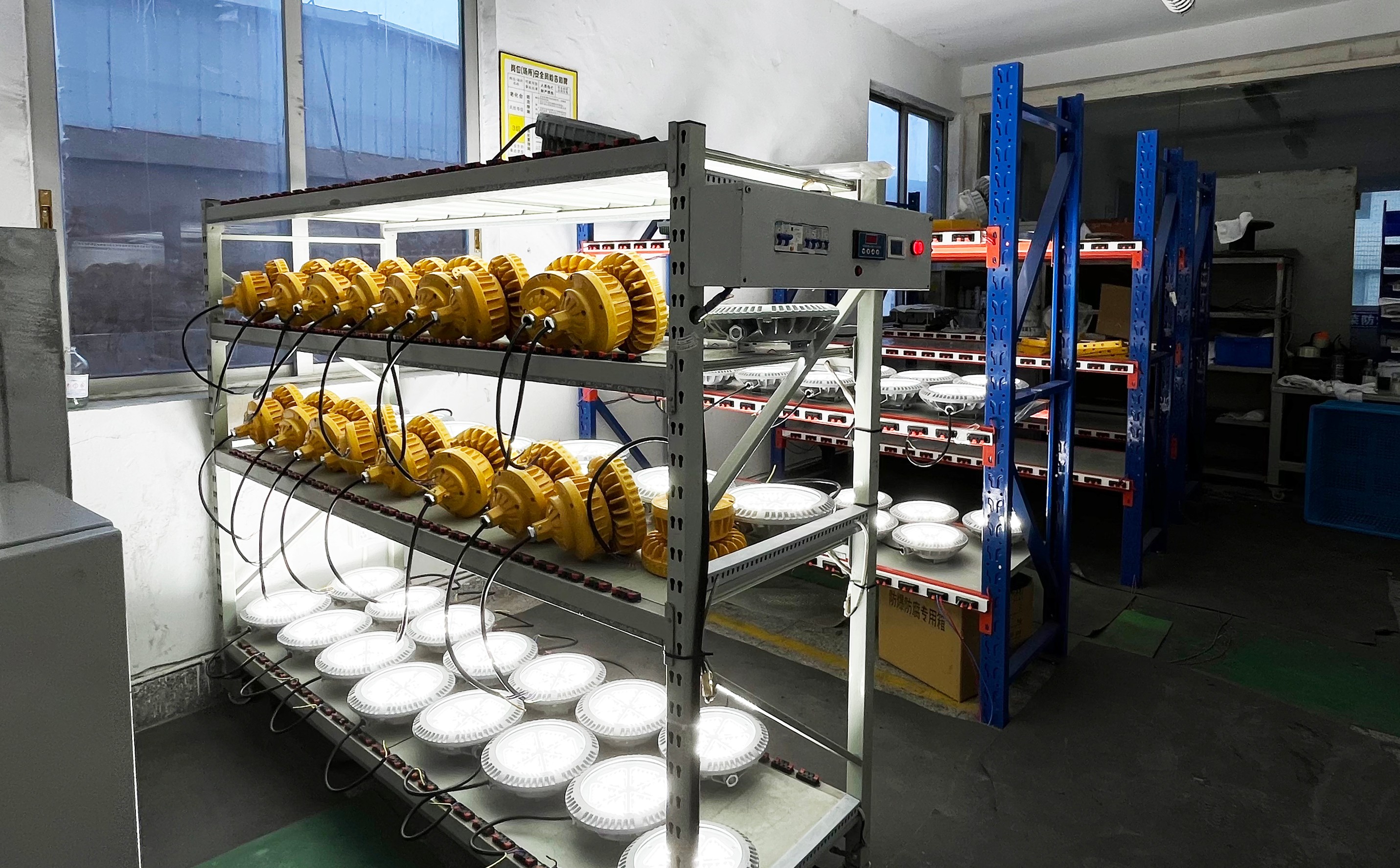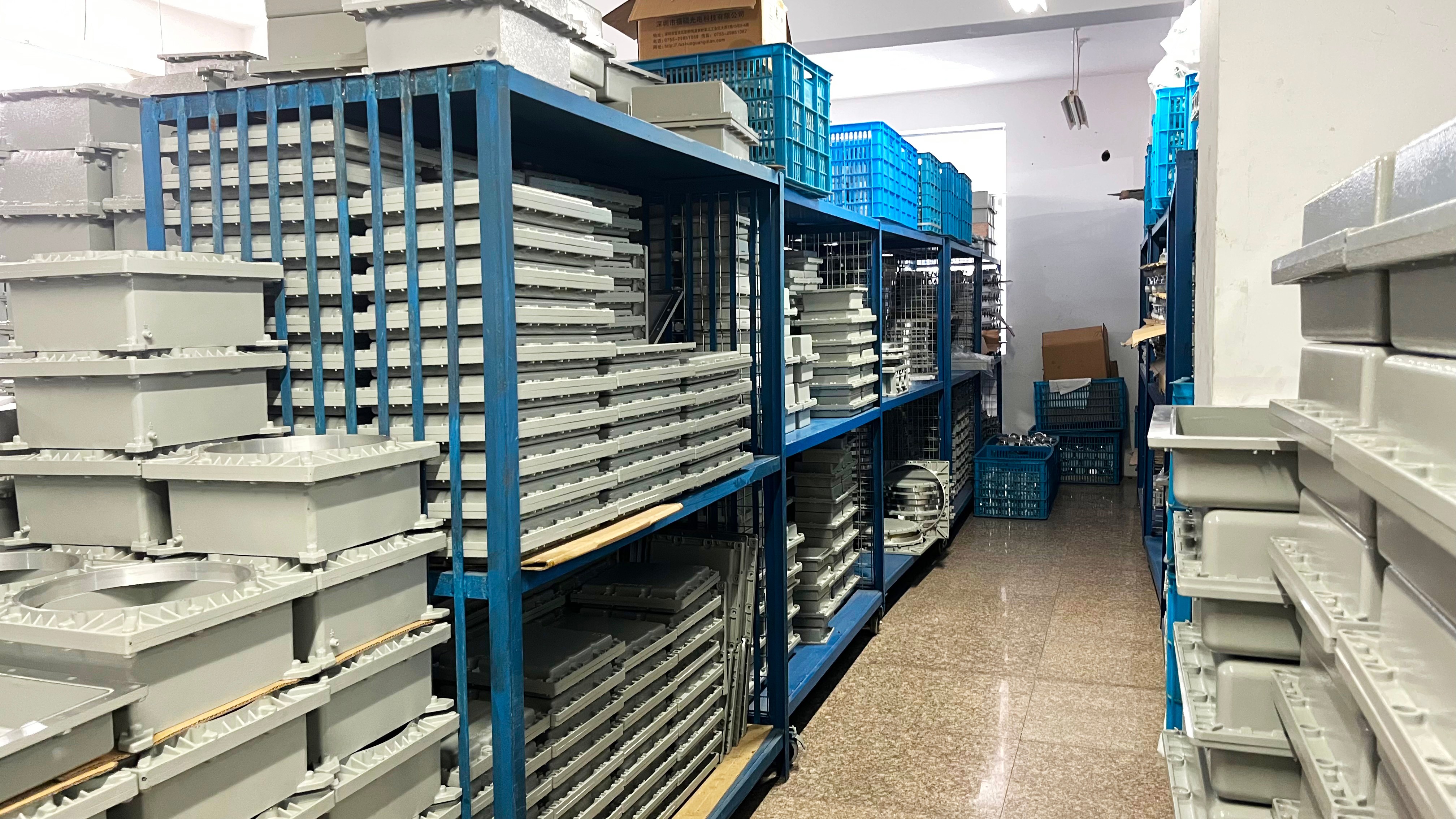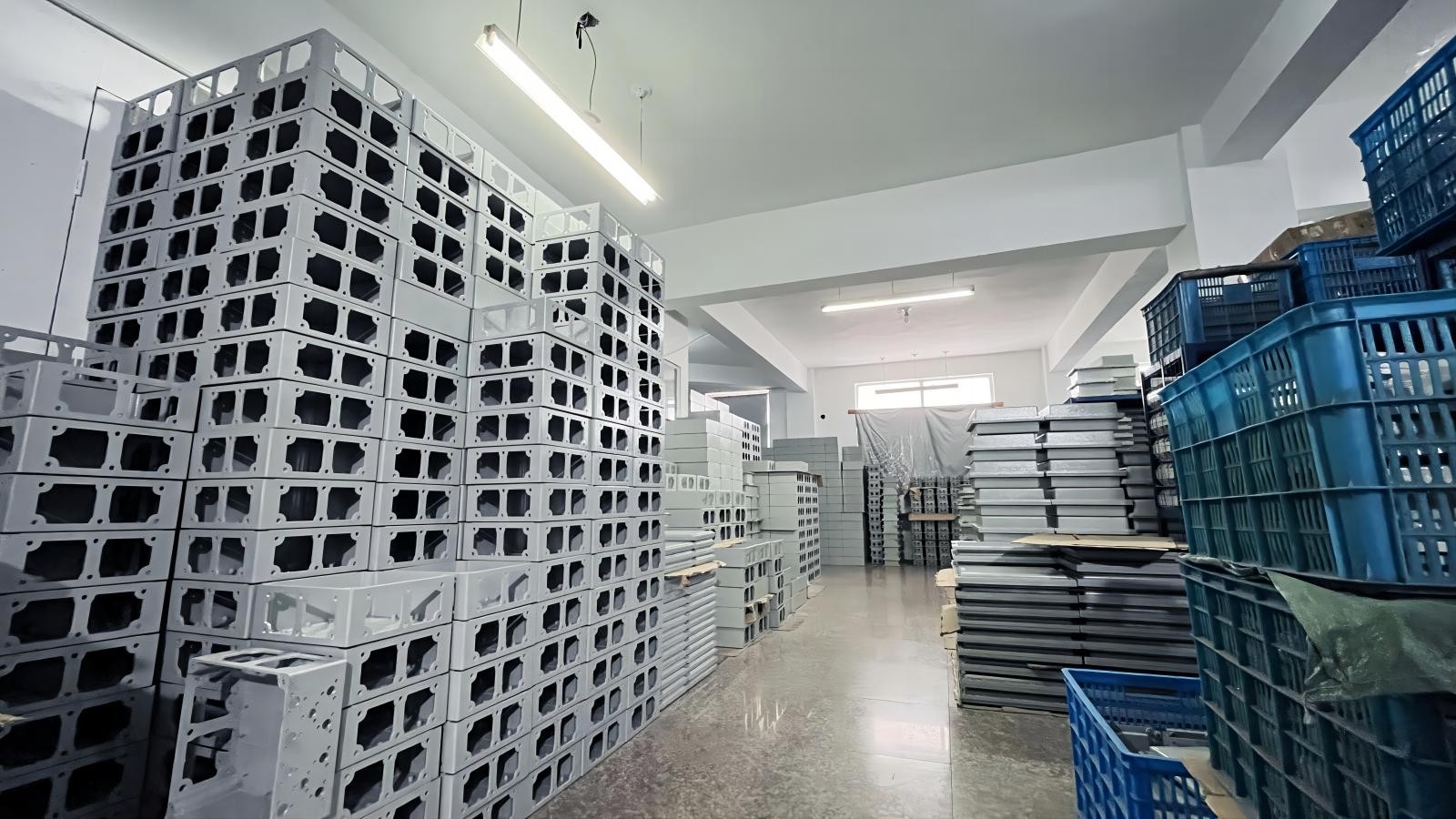Introduction

Importance of Safe Industrial Warehouse Lighting
Safe industrial warehouse lighting is essential for preventing accidents and ensuring smooth operations. Poorly lit areas can lead to mishaps, such as trips and falls, which could result in serious injuries or costly downtime. Moreover, adequate illumination helps workers perform their tasks more efficiently, reducing the risk of errors and enhancing overall productivity.
Key Considerations for Warehouse Lighting
When selecting the right type of lighting for your warehouse, several key considerations come into play. Factors such as energy efficiency, maintenance costs, and compliance with OSHA standards for warehouse lighting should be taken into account to create an optimal environment. Additionally, understanding what kind of lighting warehouses typically use can guide you toward making informed choices that align with your operational needs.
Overview of Lighting Types for Warehouses
There are various types of industrial warehouse lighting available on the market today, each suited to different applications and environments. Common options include LED fixtures known for their energy efficiency and longevity, traditional fluorescent lights that offer good initial brightness, and specialized solutions like explosion proof lighting designed for hazardous areas. Knowing which lighting system is used for industrial settings will help you choose the best fit based on your specific requirements.
Understanding OSHA Standards for Warehouse Lighting

Overview of OSHA Requirements
So, what are the OSHA standards for warehouse lighting? OSHA specifies that work areas must be adequately illuminated to ensure workers can perform their tasks safely and efficiently. This includes guidelines on minimum illumination levels, which vary depending on the specific tasks being performed within the warehouse environment.
For general warehouse areas, the standard lighting for a warehouse typically requires at least 5 foot-candles of light—enough to see clearly without straining your eyes. However, more specialized areas may require higher levels of illumination. It's essential for facility managers to familiarize themselves with these requirements to maintain compliance and safeguard employee well-being.
Importance of Compliance for Safety
The importance of compliance with OSHA standards cannot be overstated when discussing industrial warehouse lighting. Adhering to these regulations helps prevent workplace injuries caused by inadequate visibility, such as slips, trips, and falls. Moreover, non-compliance can lead to hefty fines and legal issues that could jeopardize a company's reputation.
By ensuring proper lighting conditions are met according to OSHA guidelines, warehouses can create a safer environment that promotes productivity and efficiency among employees. When workers feel secure in their surroundings due to appropriate illumination levels, they are more likely to focus on their tasks without distraction or concern about potential hazards.
Practical Tips for Meeting OSHA Standards
Meeting OSHA standards doesn't have to be daunting; there are practical steps you can take regarding industrial warehouse lighting. First off, conduct regular audits of your existing lighting systems—this will help identify any areas where light levels may fall short of requirements or where maintenance is needed due to burnt-out bulbs or outdated fixtures.
Consider investing in modern solutions like LED technology; not only do they provide better brightness compared to traditional options but also consume less energy—making them ideal for long-term savings while meeting safety standards effectively! Additionally, don't forget about training your staff on proper usage and maintenance protocols related to Hazmat storage lighting if applicable; this ensures everyone is aware of how best practices contribute towards compliance.
Choosing the Right Type of Industrial Warehouse Lighting

Selecting the appropriate type of industrial warehouse lighting is crucial for ensuring safety, efficiency, and productivity in a warehouse environment. With various options available, it’s essential to assess each type based on factors like energy consumption, brightness levels, and compliance with standards. This section will guide you through evaluating different lighting options and help you make informed decisions tailored to your specific warehouse needs.
Evaluating Different Lighting Options
When considering what type of lighting is best for a warehouse, it's vital to evaluate several options such as fluorescent, LED, and high-intensity discharge (HID) lights. Each type has its unique benefits and drawbacks; for example, fluorescent lights are cost-effective but may not provide adequate brightness over large areas. On the other hand, LED lighting has gained popularity due to its longevity and energy efficiency—making it a top contender in modern industrial warehouse lighting setups.
Another key factor in evaluating different lighting options is understanding how they align with OSHA standards for warehouse lighting. Compliance with these regulations not only ensures safety but also enhances operational efficiency by providing sufficient illumination where it’s needed most. By assessing your specific requirements against available options, you can determine which system will best meet both safety guidelines and operational needs.
Benefits of LED vs. Traditional Lighting
One cannot overlook the benefits of LED lighting compared to traditional systems when discussing industrial warehouse lighting solutions. LEDs consume significantly less energy than traditional incandescent or fluorescent bulbs while providing brighter illumination—this translates into lower electricity bills and reduced environmental impact over time. Additionally, LEDs have a much longer lifespan than their traditional counterparts; this means fewer replacements and less maintenance hassle for your facility.
Moreover, LED lights offer better color rendering capabilities which can enhance visibility in warehouses where accurate color differentiation is critical—think about identifying labels or inspecting products! Their instant-on feature eliminates warm-up time often associated with traditional bulbs; this is especially useful in environments requiring consistent operations without delays due to dimming or flickering lights. When pondering what kind of lighting do warehouses use today, it's clear that LEDs are leading the charge towards more efficient solutions.
Recommendations for High-Bay Lighting Solutions
For warehouses with high ceilings or expansive spaces needing robust illumination levels—such as distribution centers or manufacturing facilities—high-bay lighting solutions are essential. These fixtures are specifically designed to provide optimal brightness at significant heights while ensuring uniform light distribution across large areas—a critical aspect when determining what is the standard lighting for a warehouse environment.
When selecting high-bay fixtures, consider using LED high-bay lights due to their energy efficiency and long lifespan; they can dramatically reduce operational costs while improving visibility across vast spaces. Additionally, ensure that any chosen system meets OSHA standards for safe working conditions; this includes having adequate lux levels based on task requirements throughout the facility's various zones.
In summary, choosing the right type of industrial warehouse lighting involves careful evaluation of available options while prioritizing safety compliance and energy efficiency—especially when considering high-bay solutions tailored to your unique space requirements!
Exploring Hazmat Storage Lighting Solutions

When it comes to industrial warehouse lighting, ensuring safety in hazardous material storage areas is paramount. Hazmat storage lighting must meet specific requirements to protect both employees and the environment. Understanding these requirements can help you choose the right type of lighting for your warehouse and ensure compliance with regulations.
Requirements for Hazmat Lighting
Hazmat storage lighting must adhere to strict guidelines that prioritize safety and visibility. These requirements often include using explosion-proof lighting systems designed to prevent ignition of flammable vapors or dust present in hazardous material areas. Additionally, the lighting should provide sufficient illumination levels, typically between 30-50 foot-candles, depending on the specific tasks being performed—this aligns with what are considered standard lighting levels for a warehouse.
In terms of electrical standards, it's essential that all fixtures used in hazmat areas are rated for their environment, which may include wet or corrosive conditions. Moreover, regular inspections and maintenance checks are vital to ensure that the industrial warehouse lighting remains functional and compliant with OSHA standards for warehouse lighting. This proactive approach not only enhances safety but also minimizes potential downtime due to equipment failures.
Best Practices for Hazardous Material Areas
Implementing best practices in hazardous material areas is crucial for maintaining a safe working environment. First and foremost, it’s important to choose appropriate fixtures that minimize shadows and provide even light distribution throughout the space—this helps workers see potential hazards more clearly. Furthermore, consider utilizing motion sensors or timers for energy efficiency while ensuring adequate illumination when needed.
Another best practice includes clearly marking exits and emergency equipment with dedicated hazard lights; this is essential in case of an emergency situation where quick evacuation is necessary. Regular training sessions on proper handling techniques under different types of industrial warehouse lighting can also enhance employee awareness about potential risks associated with hazardous materials. Lastly, always keep aisles clear of obstructions so that emergency exits remain accessible at all times.
Examples of Effective Hazmat Lighting
When searching for effective hazmat storage lighting solutions, several options stand out as industry favorites. LED explosion-proof lights are particularly popular due to their energy efficiency and long lifespan; they also produce minimal heat compared to traditional incandescent bulbs—making them safer in flammable environments. Another excellent choice is fluorescent hazmat-rated fixtures which provide bright illumination while being cost-effective over time.
For larger spaces requiring high-bay applications, consider high-output LED fixtures specifically designed for hazardous locations—they can deliver impressive brightness while adhering to safety standards required by OSHA regulations regarding industrial warehouse lighting systems. Additionally, some manufacturers offer customizable solutions tailored to unique operational needs within your facility; this flexibility ensures you get exactly what you need without compromising safety or performance.
Evaluating Explosion Proof Lighting Systems

When it comes to industrial warehouse lighting, safety is paramount, especially in environments where flammable materials are present. Explosion proof lighting systems are designed specifically to prevent ignition in hazardous areas, making them essential for compliance and worker safety. Understanding what explosion proof lighting entails can help you make informed decisions about your warehouse's illumination needs.
What is Explosion Proof Lighting?
Explosion proof lighting refers to fixtures that are constructed to contain any explosions that occur within the light itself, preventing flames or hot gases from escaping into the surrounding environment. These specialized lights are crucial in settings where flammable vapors, gases, or dust may be present—think chemical plants or grain storage facilities. By utilizing explosion proof lighting, you ensure not only compliance with OSHA standards for warehouse lighting but also the safety of your workforce.
Ideal Applications for Ex-Proof Lighting
So, what type of lighting is best for a warehouse that handles hazardous materials? The answer often lies in explosion proof options that can withstand harsh conditions without compromising safety. Ideal applications include areas like paint booths, oil refineries, and any space where hazardous chemicals or flammable substances are stored—essentially anywhere Hazmat storage lighting would be required.
Key Features to Look for in Ex-Proof Solutions
When evaluating explosion proof lighting systems, there are several key features to consider ensuring optimal performance and safety. Look for lights with durable housings made from materials like aluminum or stainless steel that can resist corrosion and impact—this will enhance longevity and reliability in an industrial setting. Additionally, make sure the fixtures meet relevant certifications and standards; this guarantees they adhere to regulations regarding industrial warehouse lighting and will perform safely under pressure.
Standard Lighting Levels for Warehouses

When it comes to industrial warehouse lighting, understanding the standard lighting levels is crucial for ensuring safety and efficiency. The right lighting not only enhances visibility but also plays a significant role in operational productivity. In this section, we will delve into what constitutes standard lighting for a warehouse, why proper illumination is essential, and how to measure these lighting levels effectively.
What is the Standard Lighting for a Warehouse?
The standard lighting for a warehouse typically ranges from 10 to 50 foot-candles, depending on the specific tasks being performed within that space. For general storage areas, around 10-20 foot-candles may suffice, while areas requiring more precise work or inspections might need up to 50 foot-candles or more. Understanding what type of lighting is best for warehouse operations involves evaluating both the nature of the work being done and any applicable OSHA standards for warehouse lighting.
In addition to foot-candle measurements, it's important to consider uniformity in light distribution across the workspace. Spotty or uneven light can create shadows that lead to accidents or inefficiencies. Therefore, selecting a suitable industrial warehouse lighting system that meets these standards ensures that all areas are adequately illuminated.
Importance of Proper Illumination
Proper illumination in warehouses isn't just about meeting minimum requirements; it's about fostering a safe working environment. Adequate visibility reduces the risk of accidents by allowing employees to see potential hazards clearly and navigate their surroundings with confidence. Moreover, well-lit spaces can enhance worker morale and productivity by creating an inviting atmosphere.
Additionally, proper illumination can help protect inventory from damage caused by inadequate light exposure or excessive glare. This consideration is particularly important when dealing with sensitive materials or equipment that require careful handling and monitoring. Thus, understanding what kind of lighting do warehouses use becomes vital not just from a regulatory standpoint but also from an operational perspective.
How to Measure Lighting Levels Effectively
To measure lighting levels effectively in an industrial setting, utilizing a light meter is essential; this tool provides accurate readings of foot-candle levels across various areas within the warehouse. Begin by taking measurements at different heights and distances from light sources to ensure comprehensive coverage of all workspaces—this helps identify any dark spots needing additional attention or adjustment in your industrial warehouse lighting setup.
It's also wise to conduct regular assessments as part of your maintenance routine; over time, bulbs dim and dust accumulates on fixtures which can impact overall effectiveness. Consider creating a scheduled plan that includes checking existing fixtures against OSHA standards for warehouse lighting compliance so you stay ahead of potential issues before they arise.
In summary, understanding standard lighting levels is fundamental when designing an effective industrial warehouse environment—balancing safety with functionality ensures your team operates efficiently while adhering to regulations like those set forth by OSHA regarding workplace illumination.
Conclusion

In wrapping up our discussion on industrial warehouse lighting, it’s clear that proper illumination is not just a matter of aesthetics but a critical component of safety and efficiency. By adhering to OSHA standards for warehouse lighting, businesses can create safer work environments that minimize accidents and enhance productivity. As we look towards the future, understanding which type of lighting is best for warehouses will be vital in making informed decisions about upgrades and maintenance.
Best Practices for Warehouse Lighting Safety
When considering what type of lighting is best for a warehouse, it’s essential to prioritize safety first. Utilizing explosion proof lighting in areas where hazardous materials are stored ensures compliance with safety regulations while protecting workers from potential risks. Additionally, regular maintenance checks on all industrial warehouse lighting systems can prevent unexpected failures and ensure consistent illumination levels across the facility.
Implementing motion sensors and automatic dimming features can also enhance safety by reducing energy consumption while maintaining adequate visibility when needed. In terms of standard lighting for a warehouse, ensuring levels meet or exceed OSHA standards is crucial; typically, this means at least 5-foot candles in general areas and higher in task-specific zones. Moreover, training employees on the importance of proper lighting can foster a culture where everyone contributes to maintaining a safe workplace.
Considerations for Future Lighting Upgrades
As technology continues to evolve, businesses should consider how advancements in industrial warehouse lighting can improve efficiency and reduce costs over time. LED options have become increasingly popular due to their longevity and energy efficiency compared to traditional systems; they also offer better quality light output that enhances visibility throughout the workspace. When planning future upgrades, evaluating which lighting system is used for industrial applications will help determine the best fit based on specific operational needs.
Another key consideration involves assessing current layouts and workflows within the warehouse; understanding how different areas are utilized can guide decisions about whether specialized solutions like Hazmat storage lighting or high-bay fixtures are necessary. Furthermore, integrating smart technology into your illumination strategy allows real-time monitoring and adjustments based on actual usage patterns—this not only optimizes performance but also aligns with sustainability goals by minimizing waste.
Resources for Selecting Industrial Lighting Solutions
Navigating the myriad options available for industrial warehouse lighting may feel overwhelming at times; however, there are numerous resources to aid decision-making processes effectively. Industry associations often provide guidelines detailing what are the OSHA standards for warehouse lighting as well as best practices tailored specifically to various sectors within warehousing operations. Online forums and expert consultations can also offer valuable insights into what kind of lighting do warehouses use most successfully today.
For those looking into specialized applications like explosion proof or Hazmat storage lighting solutions, manufacturers’ websites often feature detailed product specifications alongside user reviews that highlight real-world performance metrics—helping you make informed choices based on actual experiences rather than just marketing claims. Lastly, attending industry trade shows or workshops presents an excellent opportunity to see new technologies firsthand while networking with professionals who share similar challenges regarding facility management.

